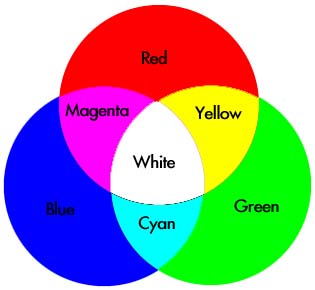I have been enrolled in art classes from a very young age. Or maybe it was just a relatively young age… Nonetheless, I’ve been in art classes for as long as I can remember.
Because of this experience, I was very familiar with color wheels: red, blue, and yellow are primary colors, green, purple/violet, and orange are secondary, etc. However, when I took  Physics my senior year of high school, I was thrown for a major loop: There was a different color wheel! Orange and Purple/Violet weren’t even mentioned; instead it was the Printer colors, cyan and magenta. Green was now a primary color and yellow was a mix of red and green. “Bizarre,” I thought. “If you mix green and red, you should get a nasty brown color, not yellow.”
Physics my senior year of high school, I was thrown for a major loop: There was a different color wheel! Orange and Purple/Violet weren’t even mentioned; instead it was the Printer colors, cyan and magenta. Green was now a primary color and yellow was a mix of red and green. “Bizarre,” I thought. “If you mix green and red, you should get a nasty brown color, not yellow.”
It took me a couple days, but I finally grasped that we were talking about light, not pigments. And that’s how the color wheels were divided up in my mind until I read more of Albers’s book yesterday; I now know that they can be referred to as additive or subtractive mixtures, also known as direct or indirect mixtures or projected or reflected light.
To add further confusion, the images seen here can be viewed as both; if you connect your computer to a projector and show the images on a screen, both images will be projected light, even the one that is representative of reflected light. The opposite can also be said if you were to  print these images onto paper; they would both be reflected light, despite the fact that one represents projected light.
print these images onto paper; they would both be reflected light, despite the fact that one represents projected light.
Albers concludes his chapter on Factual Mixtures, Chapter X, by saying that additive mixtures (direct/projected) will get lighter and more white by adding more colors, whereas subtractive mixtures (indirect/reflective) will lose light and approach blackness by adding more colors.
It seems that knowledge of multiple color wheels and the way that direct mixtures compare to indirect mixtures is one of the key concepts – or perhaps even the key concept – about color for the aspiring designer, physicist, and the average citizen.
The Physics Color Wheel aka Additive Mixture aka Direct Mixture aka Projected Light (Top Image): http://www.d.umn.edu/~mharvey/colorwheel.jpg
A Standard Color Wheel aka Subtractive Mixture aka Indirect Mixture aka Reflected Light (Lower Image): http://jbrowngraphics.com/images/Justin%20Brown_Color%20Wheel.jpg

No comments:
Post a Comment